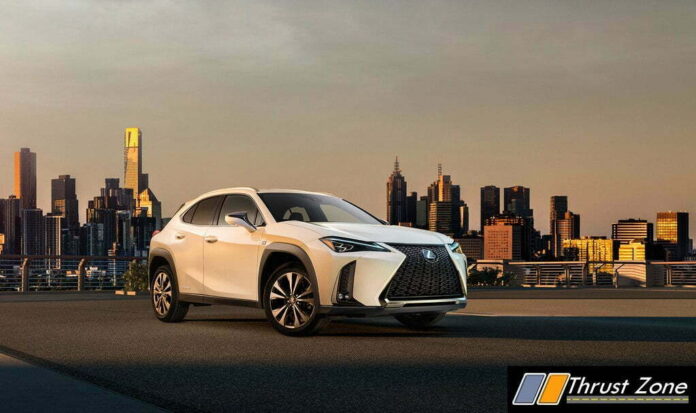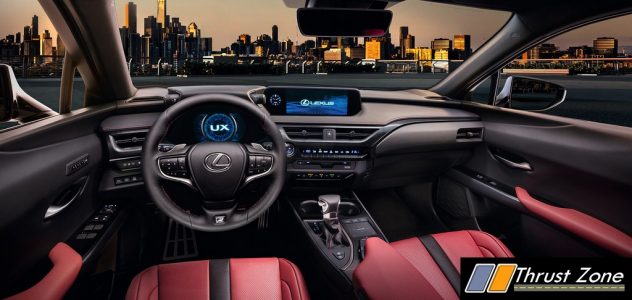Lexus UX SUV will fit below the NX series will go against the likes of the GLA and and BMW X1
The UX is a new gateway vehicle for Lexus. The development teams have worked closely to produce a car in which the exterior and interior appear almost seamlessly linked. Powerful bodywork, notable for its impressively flared front and rear wings, clothes a cabin that provides a driver-focused cockpit and an open, relaxing space for passengers. While still offering a commanding view from the steering wheel, the UX offers a driving position that makes the crossover feel more like a responsive hatchback to drive, rather than an SUV.
The UX further marks a series of technical innovations, including the first use of the new global architecture platform named GA-C, which delivers fundamental high structural rigidity and a low centre of gravity, thus securing excellent ride quality and stability. New powertrains are also deployed for the first time: a new 2.0-litre petrol engine that reaps the performance and fuel economy benefits of high thermal efficiency; and a new mid-power, fourth generation self-charging hybrid system.
Design wise, at the front, the arrangement of the headlights and the spindle grille are incorporated into a deep, strong shape. At the rear, a condensed styling treatment contrasts sharply with the flared wings
Details include daytime running lights, arranged in an arrowhead motif above the headlights to emphasise the Lexus L-shaped illumination signature. The spindle grille has a new block-shape mesh pattern with individual elements that gradually change in shape as they radiate out from the central Lexus emblem, giving a three-dimensional look that changes according to the angle of view.
The rear combination lamps have an original and advanced design that is not only eye-catching but also aerodynamically efficient while improving vehicle handling. The right and left units are connected by a continuous, single line of light across the back door to give the UX’s rear a unique appearance. Formed by a sequence of 120 LEDs, this tapers gently towards the centre, measuring just 3mm thick at its narrowest point. This design is set to become a world-first Lexus signature feature.
Four new aluminium wheel designs have been produced for the UX, with 17 and 18-inch diameters. The five-spoke 17-inch wheels have a world-first aerodynamic design, details of which are given in the Imaginative Technology section below.
Dimensions and packaging
The UX measures 4,495mm long, 1,520mm high and 1,840mm wide and has a 2,640mm wheelbase. An 870mm couple distance ensures ample space for rear seat passengers, while the load area is a generous 791mm long. The car’s proportions allow for excellent manoeuvrability, with a best-in segment 5.2m turning radius. For the driver, a reduced distance between the hip and heel points gives the feel of driving a hatchback rather than an SUV-type vehicle.
The human-centred approach extends to the design of the UX’s interior, with a “seat-in-control” concept that focuses operation of all the principal vehicle functions around the driver’s side of the cabin. At the same time, this helps create a more relaxing atmosphere around the passenger space. The instrument panel has a low, unobtrusive design and the slim A-pillar mouldings have been shaped to improve visibility and give the kind of commanding outward view that is expected of a crossover.
Getting in and out of the vehicle has been made easier and more comfortable through optimal placing of the hip-point, a cut-off profile for the rocker panel below the doors and shaping of the seat cushion.
Sashiko leather quilting
The smooth leather upholstery available for the UX is inspired by sashiko, a traditional Japanese quilting technique that is also used in the making of judo and kendo martial arts uniforms. The quilted leather is decorated with new perforation patterns that form mathematical curves and gradations in perfect alignment, enhancing the appearance of the seats.
Ornamentation inspired by Japanese paper grain
The UX’s sweeping instrument panel covers a large area, connecting the driver and passenger sides of the vehicle. This provides an opportunity to accentuate the atmosphere of the cabin using fine-quality ornamentation, with a choice of two grain patterns and four colours.
The Lexus UX SUV is the first Lexus model to offer a new trim grain finish that’s inspired by the grain of Japanese paper,known as washi, familiar in traditional Japanese homes. Created using slush-moulding and a carefully chosen surface finish. A leather grain finish is also available, shared with the LC coupe and LS flagship sedan and building a consistency of quality across the Lexus brand.
The Lexus UX SUV has been engineered to deliver “elegant performance with peace of mind” consistent in all Lexus models. The foundation is the new global architecture platform named GA-C, used for the first time in a Lexus.
Two new powertrains make their debut: a new, fourth generation self-charging hybrid system with 178 DIN hp/131kW1 and the choice of front wheel drive or E-Four in the UX 250h; and a new 2.0-litre petrol engine with high thermal efficiency, available with a new Direct Shift continuously variable transmission in the UX 200. Suspension, steering and tyres have also all been developed to support Lexus’ dynamic and performance ambitions for the UX.
First use of new global architecture platform named GA-C
The Lexus UX SUV is the first Lexus to be constructed using the new global architecture platform named GA-C, the foundation for the car’s dynamic performance. Its development focused on giving the UX nimble and instant response to the driver’s inputs, while communicating a sense of stability and safety.
The platform allowed for an increase in rigidity, including a high-tensile and ring structure around the rear and back door openings. Highly rigid adhesive and Laser Screw Welding have been used in key locations, greatly enhancing overall rigidity.
Low centre of gravity
The Lexus UX SUV has the lowest centre of gravity of any vehicle in its class, thanks to the design of the global architecture-C platform. This characteristic, central to the car’s fine ride and handling quality, is also supported by weight-saving measures in the body construction, including the use of lightweight aluminium for the side doors, fenders and hood, as well as a resin material for the back door.
Suspension and steering
MacPherson strut front suspension and a double wishbone arrangement at the rear have been designed and tuned to promote ride comfort and sharp response. Special attention has been paid to shock absorber performance and the quality of the damper oil, oil seals and friction control.
An Electric Power Steering system with a new compact and highly rigid column assist has been adopted for the UX, with a larger diameter column shaft. This supports handling with crisp, immediate response to driver inputs, with good steering feel.
Fourth generation self-charging hybrid powertrain
The Lexus UX SUV will also use a new fourth generation hybrid electric system that features a new 2.0-litre four-cylinder petrol engine and continuously variable transmission (CVT). It will be available both with front-wheel drive and with Lexus’ E-Four.
The new engine is notable for its high thermal efficiency and output, with provisional performance figures for the full hybrid self-charging system (engine and electric motor combined anticipating a maximum 178 DIN hp/131kW).
The powertrain development programme focused not just on outstanding fuel economy, but also on a high level of driving appeal. Particular efforts were made to reduce any “rubber band” effect in the operation of the hybrid system and transmission, by optimising the level of electric motor assistance and engine rpm to generate a linear acceleration feel without the engine running at high revs. Engine rpm are synchronised with the increase in vehicle speed to create an immediate and continuous acceleration feel, responding to the driver’s intentions and creating a pleasant driving feel.
New hybrid transaxle, power control unit and battery
The system has a compact and lightweight new transaxle and Power Control Unit, designed to minimise power losses through heat and friction.
A new nickel metal-hydride (NiMH) battery is used with a revised construction and more compact cooling system that allows for smaller dimensions overall. This allows the battery to be located below the rear seat, minimising intrusion in the load space and supporting the UX’s low centre of gravity.
E-Four
The E-Four system gives the Lexus UX SUV 250h all-wheel drive capability by placing an additional electric motor on the rear axle. Power distribution between the front and rear axles is automatically optimised when accelerating, cornering, or driving on slippery surfaces. When a loss of rear-wheel grip is detected, the amount of power that can be directed to the rear of the car has been increased from 60 to around 80 per cent, at speeds up to 70km/h, contributing to excellent handling stability.
Lexus UX SUV 200 with new 2.0-litre petrol engine
The Lexus UX SUV 200 is powered by a new 2.0-litre petrol engine, engineered to provide a high level of dynamic and environmental performance with excellent fuel economy. The in-line four-cylinder unit uses high-speed combustion to achieve enhanced thermal efficiency.
Features which enable this across a wide range of driving scenarios include multi-hole direct fuel injectors, a continuously variable capacity oil pump, a variable cooling system and VVT-iE intelligent variable valve-timing on the intake side. The result is a maximum thermal efficiency of around 40%―a best-in-class level for a passenger vehicle engine.
Direct Shift-CVT
The new 2.0-litre engine featured in the Lexus UX SUV 200 is matched to Lexus’ first Direct Shift-CVT, engineered to provide the smooth, fuel-efficient performance of a conventional continuously variable transmission, but with a direct driving feel. A conventional system uses two pulleys, connected by a belt, that can change their radius seamlessly, and thus change the effective gear ratio, without any “step” effect.
The new Direct Shift-CVT has additional gears to achieve acceleration at start-up like a manual transmission. This gives the smooth acceleration of a CVT, but with a direct acceleration feel. In addition, this use of gears for acceleration from start-up reduces the need for the CVT’s pulleys and belt mechanism to be used in the low gear range. This allows more room to be dedicated to the higher gear range.
High-speed, high-response gear-shifting technology, using a multiplate wet clutch developed for use in automatic transmission, is used to switch power from the gear to the belt and pulleys. This secures performance in response to different situations, from smooth and fuel-efficient driving to sporty performance with fast shifts. The design also maintains the benefits of a CVT, which can freely adjust the gear ratio to simulate changes like multi-gear automatic transmission under heavy acceleration. This gives linear acceleration feel with synchronisation of the increasing engine revs and vehicle speed.
Safety
The Lexus UX SUV is available with the latest version of Lexus Safety System +, including a Pre-Collision System (PCS) developed to be able to recognize pedestrians at night. Additionally, PCS radar detection has been extended to enable detection of cyclists during the day―road users who are involved in a high number of traffic accidents2. The package provided on the UX also includes Lexus Co DRIVE (featuring Lane Tracing Assist and Adaptive Cruise Control), Automatic High Beam/Adaptive High-beam System, and Road Sign Assist3.
A Parking Support Brake detects the risk of the vehicle coming into contact with a stationary object in its path, or another vehicle approaching from behind, and will automatically reduce drive force, initiate braking and trigger sound and visual warnings to help reduce the likelihood of a collision, or lessen the damage if an impact does occur.
World-first aerodynamic design details
Lexus took a new approach to achieve the best possible aerodynamic performance from the UX’s rear combination lamps, wheel arch mouldings and, in a world first concept, aerodynamic wheels.
The Aero Stabilizing Blade Lights in the rear incorporate fins with a distinctive design that helps prevent airflow from wrapping around the rear of the vehicle. They make a noticeable contribution to keeping the rear of the car stable when turning and driving in crosswinds. Painstaking adjustments were made to the lamps’ curved profile, with each change evaluated and verified in wind tunnel and real-world driving tests.
The wheel arch mouldings have flat sides and a stepped top section, which generates an airflow that helps keep reduce roll and keep the vehicle stable when the car is cornering, changing lanes or being driven in a straight line. Millimetre-precise adjustment of this step feature kept an optimal balance between the stabilising effect and design considerations.
The Lexus UX SUV aluminium wheels have a world-first aerodynamic design that helps both keep the brakes cool and reduce wind resistance. Computer simulations and wind tunnel testing produced a profile shape for the wheel’s spokes that increased the amount of airflow that could be directed to cool the disc brakes, without compromising the coefficient of drag (Cd).
Single knob ventilation control with wireless lighting
The Lexus UX SUV air vents have a new single-knob control for air flow direction and volume, illuminated using a new wireless system. By combining the two functions in a single control, the vents could be made larger, improving performance. Each control has an LED light source that is powered wirelessly, using electromagnetic resonance between two coils vibrating at the same frequency. Using the same design principle as the LC’s rear combination lamps, the vent lights use mirror optics to create the effect of floating lighting depth, even though the reflector element is only 3mm thick.
Predictive Efficient Drive
The Lexus UX SUV is equipped with Predictive Efficient Drive4, a Lexus-first system that analyses the driver’s driving habits and the expected road and traffic conditions to optimise charging and discharging of the hybrid battery. The more the car is driven, the more data is gathered, contributing to efficient fuel consumption. Additionally, this feature can be disabled if desired. Key components which make up Predictive Efficient Drive are as follows:
Predictive Deceleration Support
The technology was developed by driving on many actual roads in Japan and North America that represented typical traffic conditions, such as busy urban streets or mountain routes. Performance was analysed to create a control that makes the driver feel natural deceleration when it operates and which enables more efficient driving.
Using the intelligence based on accumulated knowledge about a driver’s behaviour, the system can predict when/where the vehicle is likely to slow down or stop. When UX is nearing a location where the driver has slowed or stopped in the past and the driver releases accelerator pedal, Predictive Deceleration Support triggers an increase in the amount of regenerative braking. This permits more efficient energy recovery and recharging of the hybrid battery. The system can provide deceleration support up to about 300m ahead of the vehicle.
Predictive State of Charge Control
The Lexus UX SUV also benefits from a Predictive State of Charge (SOC) control for the hybrid battery, world-first technology that functions on both downhill roads and congested routes. Operating when the car is following guidance from the navigation system, it will predict the route for a distance of up to 10km ahead.
On a long, downhill stretch of road, when there is a large amount of charge in the hybrid battery, a full charge would be reached part-way down the hill. Beyond that point, any additional, regenerated energy could not be recovered, effectively wasting it. Downhill SOC control uses gradient information from map data to calculate when a long downhill stretch of road lies ahead; when this is the car, it actively relies on EV electric driving to reduce the level of battery charge. Fuel efficiency is improved and the amount of battery charging that can be gained during the downhill section is increased.
In stop-go and low-speed driving, there is greater use of the electric motor, making it more likely the level of hybrid battery charge will be depleted. In this driving scenario, Congestion SOC control uses traffic information gathered by the navigation system to determine if there is any congestion on the vehicle’s planned route. If so, it actively charges the hybrid battery before reaching the area of congestion. This improves fuel efficiency by reducing the need of forced engine start to chargethe battery when driving in slow, congested traffic.





